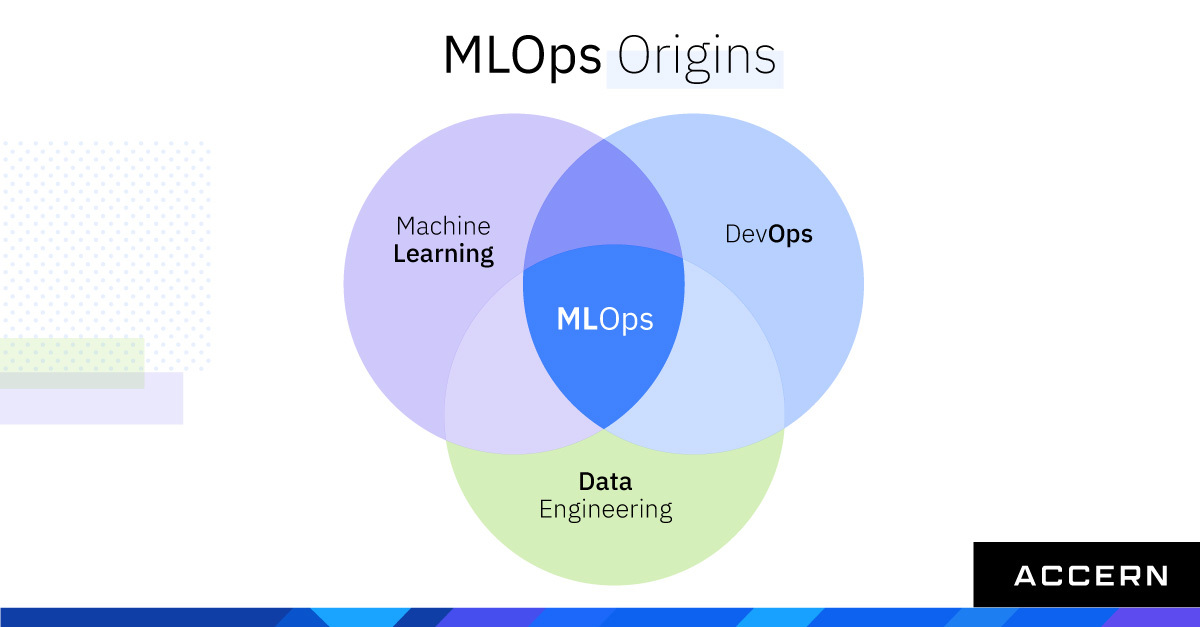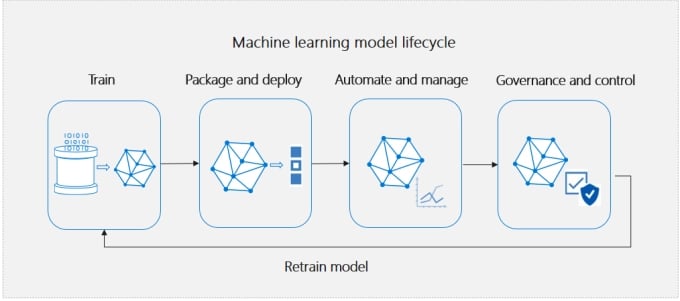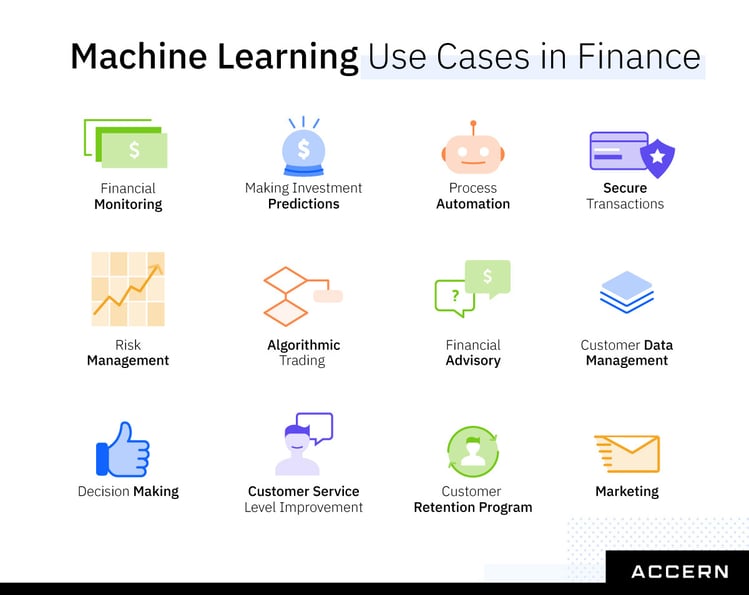What is MLOps?

Until recent years, hedge funds were the primary adopters of artificial intelligence (AI) and machine learning (ML) within the financial services industry, but what is MLOps? In recent years, the industry has seen the applications of ML spread to other areas including banks, wealth and asset management firms, and insurance firms, to name a few. From portfolio construction and optimization, to model validation, underwriting, market impact analysis, and credit risk management, the various AI and ML use cases continue to significantly impact the financial sector.
According to a recent survey by Deloitte Insights, 70 percent of financial services firms are using ML in some capacity whether in detecting fraud, analyzing credit score results, predicting cash flow, etc. However, the machine learning process is complicated and time-consuming. A partial list of steps involves collecting and storing data, cleaning, differentiating, and labeling the data, and then using the data to train, evaluate, validate, and monitor the model. In short, ML works by extracting meaningful insights from raw sets of data to obtain accurate results. The results are then used to solve complex and data-heavy problems that are critical to the finance and insurance sectors. Furthermore, ML algorithms can learn from data, processes, and techniques to find different types of insights.

Source: TechCrunch -The machine learning model lifecycle includes various stages such as model training, deployment, management and monitoring.
The multiple steps involved in ML are split across different teams and professionals with various specialities and tools. Therefore it can be hard to maintain communication between the different teams, produce quality results, and reproduce accurate results. As the use cases of ML grow within the financial services field, the challenges it brings to financial firms and their teams will remain. However, machine learning operations (MLOps), a relatively new field, is a solution for financial teams to implement machine learning with fewer steps, less technical and operational complexity, and with fewer regulations. It will soon be an industry standard as the commercial use of AI and ML expands.
MLOps Vs. DevOps
MLOps takes after the existing discipline of DevOps, which is a set of practices that brings software development and IT operations together. DevOps was created to solve the challenges of integrating various teams and professionals to make software development and deployment possible. Prior to DevOps, business users, engineers, system administrators, developers, and others would have to work together. However, DevOps provides a system that enables everyone associated in the software development and deployment process to be integrated into a single, automated workflow with the goal of rapidly delivering high-quality software that meets requirements and maintains the integrity and stability of the entire system. Under a DevOps model, development and operations teams work together across the entire software application life cycle, from development and test through deployment to operations.
MLOps is modeled after DevOps. It involves deep collaboration between the data scientists and the operations and production teams. The goal of MLOps is to eliminate waste, reduce the number of errors, and automate as many of the tasks as possible to produce richer and more consistent insights with ML. The results of ML can bring value to businesses but without some form of organization, businesses will find it difficult to obtain the value and benefits of rich and accurate results that can also be replicated. MLOp provides the systemization needed to ensure accuracy of results and agile development and deployment.
MLOps brings the best of both the business and technical sides to favor organizational interests. It gives data scientists the freedom to find answers by building and deploying models to gather insights more quickly. By removing the barriers of business and regulations from their plates, data scientists can focus on generating organizational-driven insights for better results. On the other hand, MLOps enables operations and business professionals to focus on business objectives and ensuring regulations.
How is MLOps Used Within Finance?

Leading financial firms understand the value that machine learning brings in achieving business objectives. Firms also understand that ML is extremely complex and can become more like a science experiment with all of the required steps to complete and professionals needed to work together, making it impossible to implement an effective ML strategy without MLOps.
MLOps is a type of AI model delivery that involves a set of tools and processes to allow firms to automate, scale, and standardize their ML objectives. This allows financial firms to generate significant business value while minimizing risk. Since MLOps follows after DevOps, it combines ML and operations into one workflow. MLOps enables teams to stay current with their delivery schedules and existing integration and delivery processes. It also enables them to implement ML policies and processes into the IT department, improving efficiency and scale while reducing risk to the firm. Another benefit of MLOps is that it ensures a continuous process to check that the latest features and models keep up with evolving regulatory, governance, and security needs.
The MLOps Process Lifecycle:
A MLOps process lifecycle is made up of three main parts:
- Extracting, standardizing, and cleaning the data.
- Storing data.
- Training and evaluating the model.
- Deploying and monitoring the model.
Extracting, standardizing, and cleaning data
Data is the new oil. It is also the most important component of any successful AI and ML process. With unstructured data making up the majority of data on the internet today, it is difficult to extract and analyze relevant insights. Data can be acquired in a number of different ways such as buying or leveraging open-source datasets, scraping data, generating test data, or augmenting existing data. However, to generate accurate insights, a model must be fed data that has already been cleaned and normalized.
Raw data is often unclean as it contains errors and can be corrupted. ML requires a lot of data, however, if the data is corrupted, then feeding the ML model raw data will backfire as it will result in inaccurate insights. Before feeding the model data, the data must be fixed and cleaned so that it can be optimized for faster processing and more accurate insights.
Storing data
AI and ML processes require large amounts of data to build, train, and run the models. Firms must consider where to store these workloads as high-performance and long-term data storage are the most important concerns.
When building AI models, the model is deployed against a data source so that firms can generate new insights and produce value for the business. The ML/AI model design process is iterative as models are developed, evaluated, and rebuilt and retrained when new data is added. Once new data is added, the model is refined, and the process repeats for other models.
As organizations take advantages of the capabilities of AI and ML, they will need to develop their storage strategies to ensure that data can be stored and retained long-term. For example, it may not be clear which data is useful and which isn't, so firms may want to archive the data within a public cloud or object storage database so that data can be retained in a well-indexed system that acts as a data lake. Additionally, an organization will eventually have to move active data to a high-performance platform so that data can be processed. Firms should consider high-performance options so that storage systems can act quickly and efficiently with the ML hardware.
Training and Evaluating the Model
Once data has been cleaned, normalized, and stored, it can be processed for building and training AI models. There are many variations of AI models that can be built and trained such as logistic models, time series models, and linear and non-linear models, among others. However, they all involve tuning parameters to train the models to provide the best solution to the firm's needs.
Once the model is built and trained, it must be evaluated to ensure its accuracy. The evaluation phase requires testing the model with a new set of data that had not been used with the model before. This can take multiple attempts of training the model, evaluating it, and then fine tuning or retraining until the model can solve the specific problem. Training hundred or thousands of the models to get the right one is common.
During the model training process, every action including which data source was used, what steps were taken to process the models, and what parameters were used, etc must be documented. Whichever conditions performed the best are then used to train future models. The entire process of building, training, and evaluating the model can take long hours of manual labor and collaboration between multiple teams. An MLOps pipeline can help teams collaborate easily and scale iterations with more stability and less complexity.
Deploying and Monitoring the Model
ML models must be deployed to a production environment to generate business value. Many models never make it to the production stage or the deployment process can take much longer than necessary. Even models that have been successfully deployed will require constant upkeep to new engineering and operational challenges. Implementing MLOps streamlines the process of developing and deploying models.
Once the model has been deployed, monitoring the model is one of the last part of the MLOps process. Monitoring the model ensures that the model continues to perform well and provide accurate insights. For example, a model predicting the stock market can become out of date quickly due to the fluctuations in market direction and changes in data. Therefore monitoring the activity of the model in a feedback loop is necessary to ensure it is working as intended. A feedback loop ensures the quality of the AI results by feeding new or updated data to the output of the AI model so that new versions of the model can be trained.
Conclusion
Without MLOps, financial teams are spending less time training and iterating machine learning models, and are "spending more time building and maintaining the tools for AI systems." An MLOps pipeline can help solve this challenge by allowing teams to spend more time on enhancing the accuracy of their ML models.
Effectively deploying a ML model is more than running data sets or leaving data scientists to figure out business insights and compliance rules. Production level ML requires collaboration between the operations and data teams to maximize business results. Since MLOps emphasizes operations, looking ahead to operations ensures the smooth adoption of ML and accurate, insightful results.
Although MLOps is a type of DevOps, the two end goals remain different. While DevOps is primarily focused on optimizing processes when developing a software application, the end goal of MLOps is to be used for analytics. MLOps enhances the predictive analytics processes and enables smooth, efficient, and continuous model development and deployment.
New models are rapidly emerging due to the adoption of AI and ML. Although most firms realize the value of a data-driven culture, working with models can still be challenging due to continuous digital innovations and transformations. Since models require a large amount of data and firms use various tools to analyze the information and build out models, the risks of human error are high.
MLOps can help develop clear communication between data, operations, and business teams. Firms implementing MLOps will have more consistent results as MLOps ensures that handoffs in each stage of ML model production and the deployment of models are efficient and consistent. With MLOps, firms can automate workflows and manage resources and monitor, scale, and customize models.
Learn more about Accern's no-code ML solutions in our blog post, Adaptive Modeling: Building Models That Last.
For more information on how your firm can automate workflows, build custom models, and scale, request a demo.
About Accern
Accern is a no-code AI platform that provides an end-to-end data science process that enables data scientists at financial organizations to easily build models that uncover actionable findings from structured and unstructured data. With Accern, you can automate processes, find additional value in your data, and inform better business decisions- faster and more accurately than before. For more information on how we can accelerate artificial intelligence adoption for your organization, visit accern.com